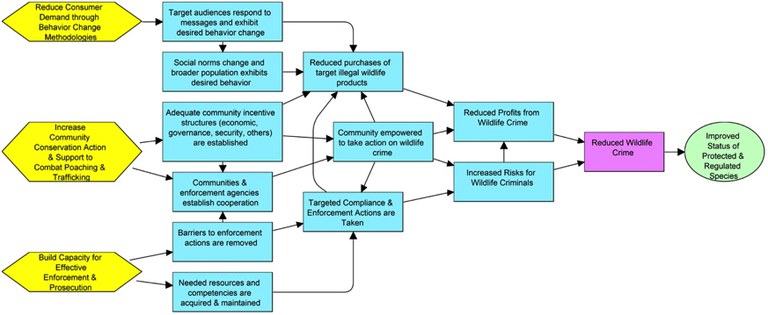Cross-Mission Learning Agenda for Combating Wildlife Trafficking
|
| Learning Questions |
Envisioned Learning Activities |
Proposed Learning Products |
Use/Value of Learning Products |
| Strategic Approach 1: Reduce Consumer Demand Through Behavior Change Methodologies |
|
Guiding question: What does effective demand reduction look like?
|
Group members share their experience and learn about the evidence base and best practices for demand reduction approaches
To support this activity, Measuring Impact will:
Provide direct support to missions to define MEL Plan/indicators and generate evidence
Collect information on what is working and what is not in monitoring demand reduction activities
Examine and disseminate new tools on demand reduction |
Contributions to the online repository of lessons posted on the wiki
Examples or models of behavior change indicators (case studies, brief, webinars with experts)
Compilation of demand reduction "best practice" materials (demand reduction toolkit website, case studies on the Learning Group website)
Webinars or in-person presentations of new information and evidence to the Learning Group and others
Webinars and/or in-person presentations of the results to the Learning Group and others
Discussions via the Google email group |
The learning activities and products will help USAID:
Design and implement more effective demand reduction strategic approaches
Identify appropriate indicators to track project progress and effectiveness
|
|
What is the effect of reducing supply of illegal wildlife products as a consumer demand reduction strategy?
|
|
What are the most appropriate metrics and methodologies for monitoring demand reduction activities, especially the link between attitudes and behavior change?
|
|
Are certain messaging strategies more effective than others (i.e., positive messaging, messaging with enforcement information, etc.)?
|
| Strategic Approach 2: Build Capacity for Effective Enforcement and Prosecution |
|
Guiding question: What are the characteristics of effective law enforcement capacity building?
|
Group members share their experience and learn about the evidence base and best practices for capacity building for CWT
To support this activity, MI will:
Organize a case study collection (open to interagency and USAID) and a learning event for socialization
Comparison of Illegal, Unreported, and Unregulated (IUU) fishing, timber, and CWT interagency activities (common threats, drivers, barriers, and approaches) to harvest potential new approaches and methodologies |
Contributions to the online repository of lessons posted on the wiki
Case study briefs from entries (from case study collection)
Summary brief on best practices in law enforcement capacity building, including measuring outcomes (derived from case studies and learning event)
Diagnostic tool to identify barriers and approaches to implementing desired actions
Collection of training resources (who is doing what, where, and when)
Webinars or in-person presentations of new information and evidence to the Learning Group and others
Discussions via the Google email group |
The learning activities and products will help USAID:
Apply tools and evidence to design and implement more effective capacity building approaches
Identify potential barriers and challenges to the sustainability of capacity building efforts
Measure progress of and effectiveness of different approaches
|
|
How do institutional arrangements, especially dedicated units and embed programs, impact the uptake of skills and knowledge?
|
|
What are good examples of systems, particularly judicial systems, which have made improvements in CWT enforcement?
|
|
What factors are necessary for effective cooperation and processes among national, sub-national, and local authorities, especially for Wildlife Enforcement Networks?
|
|
What are some successful examples of partnerships used to deliver competency-building activities and what made them work?
|
|
For specific audiences: Which competency-building methods and content works best, especially for maintaining skills and retaining staff?
|
| Strategic Approach 7: Increase Community Conservation Action & Support to Combat Poaching & Trafficking |
|
Guiding question: What is best practice for community engagement on wildlife crime?
|
Group members share experiences and learn about the evidence base for increasing community conservation action and support to combat poaching and trafficking
To support this activity, MI will:
Disseminate Wilkie, et al. (Rewards and Risks Associated with Community Engagement in Anti-Poaching and Anti-Trafficking) through webinars, newsletter, google discussion group, etc.
Synthesize available information on the conditions under which community members are more likely to work with enforcement agencies (What is the tipping point? What are the economics underlying the tipping point?) |
Contributions to the online repository of lessons posted on the wiki
Webinars or in-person presentations of new information and evidence to the Learning Group and others
Discussions via the Google email group |
The learning activities and products will help USAID:
Identify the enabling conditions that may be important for community management of wildlife
Design effective approaches to enable community-government collaboration in combating wildlife trafficking |
|
When are certain community incentive structures (economic, governance, security, others) more important relative to others?
|
|
What are successful examples of community-government collaboration that have resulted in increased support for combating wildlife trafficking?
|


